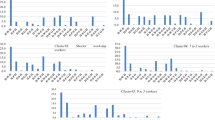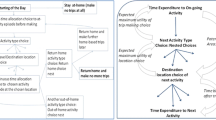Abstract
The current lack of a detailed description of elderly travel characteristics and behaviours, particularly one that examines the issue at a level involving activity engagement, was a deficiency addressed by this research. Using data from the 1994/95 Portland, Oregon, Household Activity and Stated Preference Survey a simplified activity-based travel model for the elderly was developed and validated. The modelling framework makes use of lifestyle groups which are delineated through advance analyses. The final cluster solution chosen to provide a categorical basis for the modelling framework identified six distinct lifestyle groups based on socio-demographic variables. The clusters were subjectively labelled Workers, Mobile Widows, Granny Flats, Mobility Impaired, Affluent Males, and Disabled Drivers. The clusters were found to have statistically significant differences in travel behaviour and activity engagement patterns. These findings are useful to policy-makers who attempt to balance the mobility needs of the elderly with the prospect for stricter driving license policies in response to traffic safety concerns. The model framework successfully replicated all facets of the base data set used for its development. Using a sequential process, the micro-simulation model employs a bottom-up approach by stochastically developing daily activity itineraries for individuals which are subsequently assembled into trip tours. Elements of travel behaviour synthesized for individuals being modelled included total daily activities (with and without travel), activities engaged in by class (with and without travel), total daily trip tours, and mode splits.The research has shown that a categorical approach using lifestyle groups with unique activity and travel characteristics can be successfully combined within an activity-based framework. Although this approach was applied specifically to the elderly, it can be extended to other heterogeneous groups including the population as a whole. Furthermore, the study has provided a more comprehensive understanding of the varied lifestyles, activity patterns, and subsequent travel behaviour and needs of the elderly.
Similar content being viewed by others
References
Burkhardt JE & McGavock AT (1999) Tomorrow's older drivers: Who? How many? What impact? Transportation Research Record 1693: 62–70.
Burkhardt JE (1999) Mobility changes: Their nature, effects, and meaning for elders who reduce or cease driving. Transportation Research Record 1671: 11–19.
Cambridge Systematics Inc. (1996) Data collection in the Portland, Oregon metropolitan area: case study. Technology Sharing Program, United States Department of Transportation, Washington, DC.
Chu XH (1994) The effects of age on the driving habits of the elderly. Prepared for the office of University Research and Special Programs Administration, United States Department of Transportation, Washington, DC.
Ettema DF & Timmermans HJP (1997) Activity-Based Approaches to Rravel Analysis. New York: Pergamon, Elsevier Science.
Goulias KG, Pendyala RM & Kitamura R (1991) Practical method for the estimation of trip generation and trip chaining. Transportation Research Record 1285: 47–56.
Hildebrand ED (1998) An Activity-Based Travel Needs Model for the Elderly. PhD Dissertation. University of Waterloo, ON, Canada.
Kitamura R (1997) Applications of models of activity behaviour for activity based demand forecasting. Proceedings of the Activity-based Travel Forecasting Conference. Sponsored by the Travel Model Improvement Program, Federal Highway Administration, Washington DC.
Norušis, MJ (1993) SPSS®for Windows™ : Base System User's Guide Release 6.0. Chicago, IL: SPSS Inc.
Principio SL & Pas EI (1997) The sociodemographics and travel behaviour of lifestyle groups identified by time use patterns. Presented at the 76th annual meeting of the Transportation Research Board, Washington DC.
Rosenbloom S (2001) Sustainability and automobility among the elderly: An international assessment. Transportation 28: 375–408.
Stamatiadis N & Deacon JA (1998) Are older drivers safer today than in the past? Swedish National Road and Transport Research Institute, VTI Conference 9A part 4, pp. 21–39.
Zhou M & Lyles RW (1997) Mobility patterns of the next generation of older persons. Transportation Research Record 1573: 99–104.
Author information
Authors and Affiliations
Rights and permissions
About this article
Cite this article
Hildebrand, E.D. Dimensions in elderly travel behaviour: A simplified activity-based model using lifestyle clusters. Transportation 30, 285–306 (2003). https://doi.org/10.1023/A:1023949330747
Issue Date:
DOI: https://doi.org/10.1023/A:1023949330747




